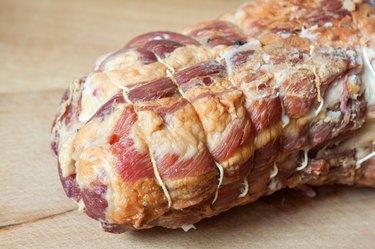
As a somewhat fatty cut of meat, lamb shoulder is best cooked slowly, either roasted or braised. Unlike the lean leg of lamb, shoulder is laced with fat and tissue that melts into the meat when slowly cooked, resulting in very tender, succulent meat, though you can trim away some of the outer fat if you prefer. Because the shoulder bone is awkwardly-shaped and difficult to carve around, you'll often find lamb shoulder boned and rolled, tied up in string to keep it together at the grocery store. Once cooked, you can simply cut off the string, carve and enjoy.
Slow-Roasted
Video of the Day
Step 1
Removed your boned and rolled shoulder of lamb from the refrigerator and let it come to room temperature, up to two hours before you plan to cook it.
Video of the Day
Step 2
Preheat your oven to 275 degrees Fahrenheit and season the lamb generously with sea salt, pepper and other seasonings as you see fit, such as smashed garlic, minced onions, fresh rosemary, thyme or lemon zest to brighten the flavors. Lift the twine on the roast to get seasoning underneath it.
Step 3
Placed the lamb shoulder on a wire rack set on a foil-lined baking sheet and transfer it to the oven. Allow the lamb to cook for about 3 hours for a 3- to 4-pound roast, until the roast is within 5 degrees of 145 F, the minimum required temperature for safe consumption, according to FoodSafety.gov.
Step 4
Remove the roast from the oven and allow it to rest for 30 to 40 minutes, loosely covered in foil. This will allow the roast raise at least another 5 degrees to reach 145 F and allow the juices to redistribute throughout the meat. Cut away the twine holding the roast together before carving and serving.
Braised
Step 1
Preheat your oven to 325 F. Season the boneless rolled shoulder generously with salt and pepper, as well as any additional seasonings of your choice.
Step 2
Coat the bottom of a Dutch oven with olive oil and set it on the stove over high heat. Brown the lamb shoulder in the hot oil on all sides, using metal tongs to lift and turn it. Remove the lamb from the Dutch oven and set aside on a plate.
Step 3
Pour out the excess fat from the Dutch oven to prepare for braising, leaving just a thin layer on the bottom for sauteeing. Add diced onions or shallots and saute over medium heat, until translucent and slightly browned. You can also add vegetables such as chopped celery and carrots.
Step 4
Add a braising liquid of your choice to the Dutch oven, such as white or red wine, beef stock, or a combination of wine and beef stock. You want to use enough liquid to come halfway up the lamb shoulder.
Step 5
Scrape up the browned bits of onion and other vegetables that may have stuck to the pan, which will add flavor to the braising liquid.
Step 6
Add the lamb shoulder into the braising liquid and cover the Dutch oven with its lid. Bring the liquid to a simmer, then place in the preheated oven. Allow it to cook for about 2 1/2 to 3 hours, for a 5 to 6-pound lamb shoulder, turning it halfway through, until the internal temperature has reached within 5 degrees of 145 F.
Step 7
Transfer the lamb to a serving platter and cover it loosely with aluminum foil to let it rest and fully reach 145 F. At this point you can boil the braising liquid to reduce it into a thick sauce, which you can then pour over the lamb after carving it.
Things You'll Need
Salt
Pepper
Additional seasonings, optional
Baking sheet
Aluminum foil
Dutch oven
Olive oil
Metal tongs
Aromatics, like diced onions or shallots
Additional chopped vegetables (optional)
White or red wine (optional)
Beef stock (optional)
Tip
For a crispier exterior when roasting, increase the temperature of the oven to 500 F after it has rested and return the lamb to the oven for about 15 minutes to get it well browned and crisp.
Wine is ideal for braising various meats as it adds acidity, helping to break down the connective tissues in the meat further, in addition to adding robust flavor.